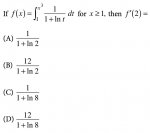\(\displaystyle \displaystyle \mbox{If }\, f(x)\, =\, \int_1^{x^3}\, \dfrac{1}{1\, +\, \ln(t)}\, dt\, \mbox{ for }\, x\, \geq\, 1,\)
\(\displaystyle \displaystyle \mbox{then what is the value of }\, f'(2)\,\mbox{?}\)
. . .\(\displaystyle \mbox{(A) }\, \dfrac{1}{1\, +\, \ln(2)}\)
. . .\(\displaystyle \mbox{(B) }\, \dfrac{12}{1\, +\, \ln(2)}\)
. . .\(\displaystyle \mbox{(C) }\, \dfrac{1}{1\, +\, \ln(8)}\)
. . .\(\displaystyle \mbox{(D) }\, \dfrac{12}{1\, +\, \ln(8)}\)
Why D is correct?
\(\displaystyle \displaystyle \mbox{then what is the value of }\, f'(2)\,\mbox{?}\)
. . .\(\displaystyle \mbox{(A) }\, \dfrac{1}{1\, +\, \ln(2)}\)
. . .\(\displaystyle \mbox{(B) }\, \dfrac{12}{1\, +\, \ln(2)}\)
. . .\(\displaystyle \mbox{(C) }\, \dfrac{1}{1\, +\, \ln(8)}\)
. . .\(\displaystyle \mbox{(D) }\, \dfrac{12}{1\, +\, \ln(8)}\)
Why D is correct?
Attachments
Last edited by a moderator:

